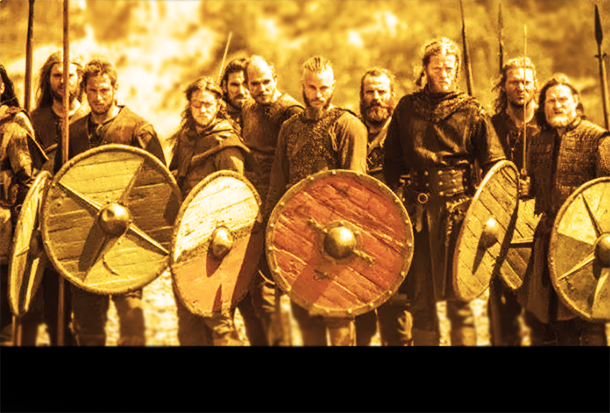“The history books will need to be updated.”

The origin of Viking people in Scandinavian is steeped in legend and lore. Referred to as as the Norse men, they emerged as a dominant forces in northern Europe in 8th century, leveraging their advances in marine navigation technology and sea route trading.
Yet, there is still much we don’t know about the genetic origins of this influential group. A new DNA study reveals new clues as to the true roots of the Viking people.
Sarah Wells of Inverse reports…
History books typically depict Vikings as blue-eyed, blonde-haired, burly men sailing the North Atlantic coast to pillage wherever they set foot on land. While some of that may be true, a new genetic study of Viking DNA is flipping much of this history on its head.
In the largest genetic study of Viking DNA ever, scientists have found that Vikings — and their diaspora — are actually much more genetically diverse than we may have thought and were not necessarily all part of a homogenous background.
Sequencing the genomes of over 400 Viking men, women, and children from ancient burial sites, researchers found evidence of genetic influence from Southern Europe and Asia in Viking DNA dating back to before the Viking Age (750 – 1050 A.D.).
The authors also note that individuals not related to Vikings genetically, such as native Pictish people of Scotland and Ireland, sometimes received traditional Viking burials — suggesting that being a Viking was not so much about specific family roots but about a sense of internal identity.
In the study, published Wednesday in the journal Nature, an international team of researchers reports findings from their six-year-long study of 442 human remains from burial sites that date back between the Bronze Age (2400 B.C.) to the Early Modern period (1600 A.D.)
When comparing the genetic material of these ancient samples with 3,855 present-day individuals from regions like the United Kingdom, Denmark, and Sweden, and data from 1,118 ancient individuals, they discovered more intermixing of genetic material than they’d originally imagined, lead author and director of The Lundbeck Foundation GeoGenetics Centre at the University of Copenhagen, Eske Willerslev, said in a statement.
“We have this image of well-connected Vikings mixing with each other, trading and going on raiding parties to fight Kings across Europe because this is what we see on television and read in books — but genetically we have shown for the first time that it wasn’t that kind of world,” explains Willerslev.
“This study changes the perception of who a Viking actually was — no one could have predicted these significant gene flows into Scandinavia from Southern Europe and Asia happened before and during the Viking Age.”
Based on these results, Willerslev says that even well-known imagery of Vikings being blonde and blue-eyed (like Chris Hemsworth’s depiction of Thor) may not be totally true, especially for Vikings with Southern European roots. The authors write that their analysis also confirmed some long-held theories and hunches about the movement of Vikings during this time.
One of the first hunches that the study was able to confirm was the final destination of different threads of Viking migration from modern-day Scandinavia.
The DNA of ancient Danish Vikings cropped up in England while Norwegian Viking DNA was found in Ireland, Iceland, and Greenland. Unexpectedly though, they also found evidence of DNA similar to present-day Swedish populations in the western edge of Europe and DNA similar to modern Danish populations further east.
The researchers write that this unexpected discovery suggests that complex settling, trading, and raiding networks during these times resulted in communities of mixed ancestry.
Even more, the study’s analysis shows that this mixed ancestry was taking place even before the so-called Viking Age, explains Martin Sikora, a lead author on the study and associate professor at the Centre for GeoGenetics, University of Copenhagen.
“We found that Vikings weren’t just Scandinavians in their genetic ancestry, as we analyzed genetic influences in their DNA from Southern Europe and Asia which has never been contemplated before,” said Sikora. “Many Vikings have high levels of non-Scandinavian ancestry, both within and outside Scandinavia, which suggest ongoing gene flow across Europe.”
And some “Vikings” weren’t of genetic Viking descent at all, researchers found when analyzing a Viking burial site in Orkney, Scotland. Despite being put to rest in traditional Viking style (including swords and other Viking memorabilia,) when sequencing the DNA of these remains the authors found that the two individuals buried at this site were in fact of Pictish (or, early-Irish and early-Scottish) decent.
The researchers write that this discovery suggests that being a Viking was not necessarily about how far back your Nordic roots reached but instead had more to do with one’s lived identity.
“The results change the perception of who a Viking actually was,” said Willerev. “The history books will need to be updated.”
In addition to providing a more nuanced look at this transformational period of history, this new genetic insight can also help scientists better understand how different traits, like immunity, pigmentation, and metabolism, are selected for across genetic groups…
Continue this article at Inverse
READ MORE HISTORY NEWS AT: 21st Century Wire History Files
SUPPORT OUR WORK BY SUBSCRIBING & BECOMING A MEMBER @21WIRE.TV















